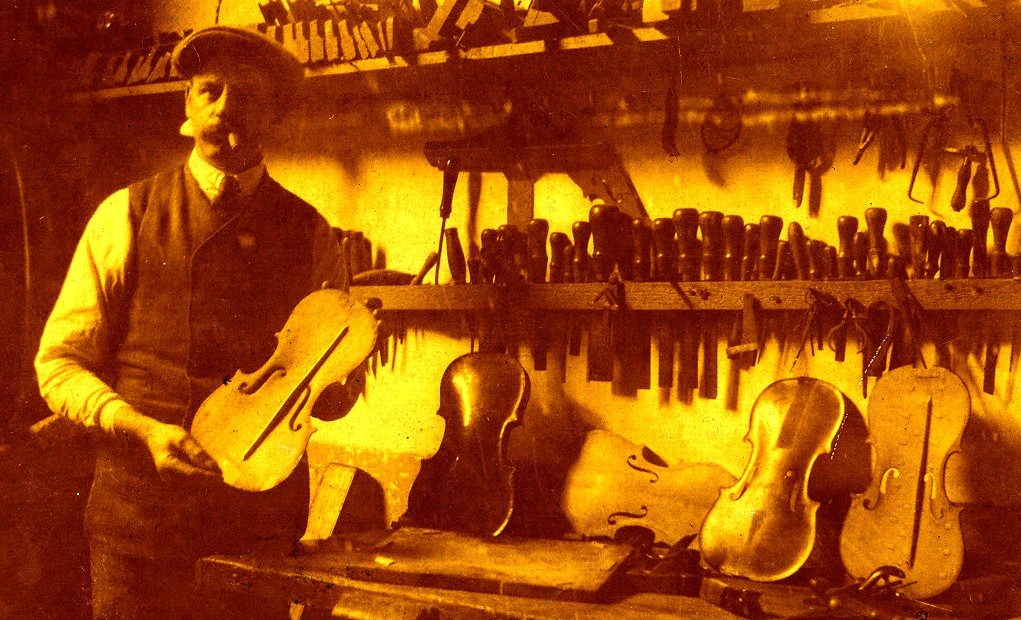Cornelis Jacobus Henderikus Blomhoff was born in Leeuwarden on March 19th
1887. In his youth he spent some years in Germany as his family had migrated to
Barmen-Elberfeld to find work. When Cornelis is 13 years old his father is
killed in an industrial accident. Father Hans was employed as a stucco-worker in
a house under construction in Elberfeld. The widow – Elisabeth Hamringa –
returns to Leeuwarden where her son Albert continues his father’s stucco-work
business.
Cornelis
is apprenticed to his uncle, Jetse Hamringa, master-carpenter in the village of
Dronrijp. Not only does he learn the carpenter’s trade, but he also becomes
proficient in its more artistic aspects, such as wood-carving, sculpturing and
marquetry.

Cornelis Blomhoff
in his workplace of the Sint Anthonij Gasthuis in Leeuwarden. Photo Klaas Kueter, solo cellist Frysk Orkest.
After
having been employed by a few different building-contractors, Cornelis is
appointed as a carpenter in the Sint Anthonij Gasthuis (home for the elderly) in
Leeuwarden in 1912. Willem Cornelis de Groot, architect, has recommended him to
the board of governors because of his professional craftsmanship. Here he can
use his knowledge and skills in restoring furniture and wainscoting. In the
little spare time he has, he starts making musical instruments. A rather painful
incident had caused his interest in making violins – at least according to
family tradition. As a young boy Cornelis had secretly played his brother’s
cither. The instrument got damaged and Cornelis had no choice but to repair the
cither so painstakingly that his brother would never find out. In this he
succeeded.
The
first violins he made were a success and were in demand by both amateur and
professional musicians in Leeuwarden. Making or repairing string instruments
helps to make him earn a pretty penny on the side. Even though all this work
has to be done in his spare time, the board of governors of the St. Anthony Gasthuis urge him to proceed.
In June
1928 the great Dutch Musical Exposition takes place in Scheveningen. Cornelis
decides to send in some of his violins. That was easier said than done, because
when the exposition was announced, he had no new violins in stock. So for some
months that results in his spending all his spare time - sometimes until late
at night – in the making of two violins. However, all his effort was not done in
vain, for the exposition is a great success for him. His name becomes well-known
all over the world. The violinist, violin-pedagogue and curator of the
Muziekhistorisch Museum Scheurleer in the Hague, Dirk J. Balfoort writes him a
letter when the exposition is over …..”that your exhibit was extremely
successful and has drawn a lot of attention. The violins are extremely well made
and their sound is fantastic. When no one was present I seized the opportunity
to play your instruments and I was struck by their pleasant, clear and powerful
sound”.
Besides
violins, violas and cellos Cornelis Blomhoff makes a number of “historical”
instruments. At the time the ensemble Collegium Musicorum organises a number of
concerts. The musicians play copies of old instruments, such as the quinton, the
viola da gamba and the viola da brachio made by Blomhoff. Collegium Musicorum
plays a repertory from the time those instruments were in use and is dressed in
18th century fashion.

The Collegium Musicorum from Leeuwarden. The quinton
of Roel Sipkens (m.) the viola d'amore of Salvatore Sterck (r.)
and the
viola da gamba of Klaas Kueter (l.) has been made by Cornelis Blomhoff. Second from the
left Henk Gramsma and at the harpsichord Coba Kueter-Zwager.
Cornelis
Blomhoff also became well-known for his fiddle-sticks. He made his last series
of violins in 1953. Many members of the Frysk Orkest as well as many amateurs
find their way to Blomhoff when their instruments need to be repaired or
restored. His fame in this field is even larger than his fame as a violinmaker.
Towards
the end of the fifties Blomhoff also stops repairing instruments. He dies in
Steenwijkerwold on December 24th ,1967.